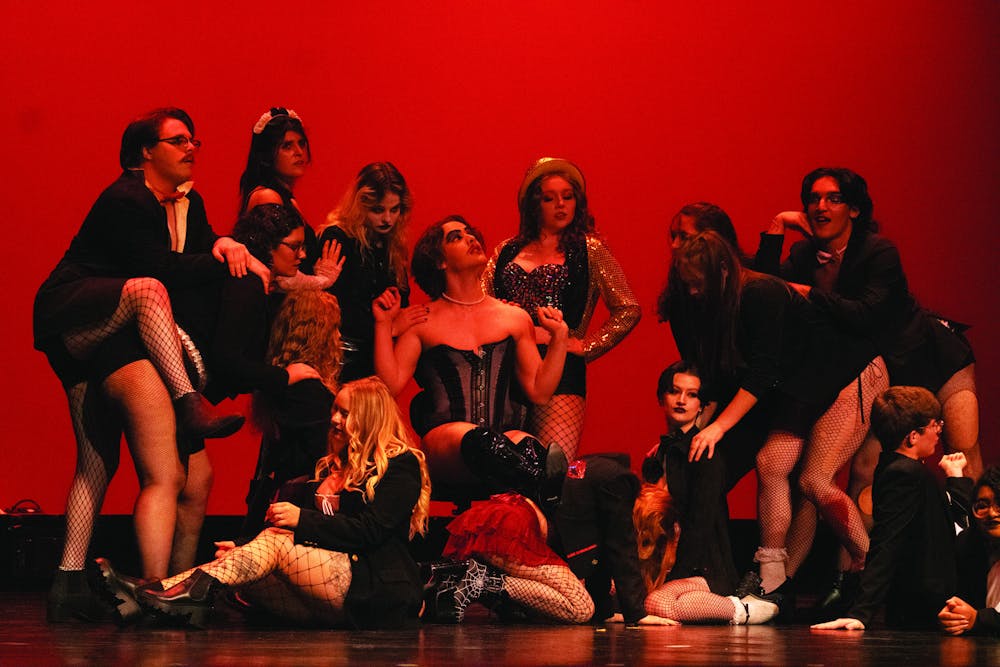Celebrating the 50th anniversary of the 1975 movie, the Rocky Horror Picture Show returned to Shippensburg University’s Memorial Auditorium, with a three-night showing from Friday, Oct. 31, to Sunday, Nov. 2.
Like in previous years, this performance of Rocky Horror was directed and performed by students and was sponsored by the PAGE Center and the Trans Affinity group.
According to director Alyssa Sheriff, work on this year’s production began in October 2024. Sheriff and choreographer Ari Stevens have spent the past year putting together new ideas for the 2025 performance. Rehearsals started in the second week of September 2025.
Originally a 1973 stage performance in London, the Rocky Horror Picture Show gained its cult popularity following the release of the 1975 horror-comedy musical of the same title.
As a cult classic work with themes relating to the expression of gender identity and sexual freedom, Rocky Horror has had an immense following within the LGBTQ+ community over several decades. This legacy has continued at SU under the direction of Sheriff and Stevens.
“Rocky Horror stage shows have been a long-standing tradition for the past 50 years that it has existed in the public sphere,” Sheriff said. “[It] was a catalyst for queer representation in media — allowing it to remain relevant and important today.”
In keeping touch with Rocky Horror’s LGBTQ+ popularity, she explained how all donations received are given to Trans Affinity, a group that provides gender-affirming items for transgender and genderqueer individuals.
Prior to the beginning of the performance, Sheriff and Stevens gave a brief warning on the more dated and complicated depictions in Rocky. The play features scenes where characters are coerced into sexual acts.
Additionally, they explained how the terminology used to describe the iconic “sweet transvestite from Transylvania,” Dr. Frank-N-Furter, has not aged well 50 years following the original. Terms like “transvestite” and “transsexual” are considered by many to be outdated, with the term “transgender” being more widely accepted.
According to Sheriff, in recognizing the harm that comes from nonconsensual acts and LGBTQ+ misrepresentation, signs were held during the touchier scenes that read “coercion is not consent” and featured a QR code that links to a video about the importance of consent.
Audience callouts are an important aspect of Rocky Horror showings. Throughout the performance, audience members were encouraged to get involved by shouting lines from the movie’s many famous songs or by playfully making fun of the characters.
When the characters Janet Weiss and Brad Majors appeared on stage, they were often met with calls of “sl*t” and “*sshole,” respectively. Though confusing for a first-time viewer, it was recognized by the director and cast as an integral in-joke within the performance.
Self-expression and the opportunity to step out of your comfort zone have also always been a critical part of the musical. This year’s performance of Dr. Frank-N-Furter was played by Tommy Landis, who spoke on what he liked about the character and how he felt performing in the show.
“Frank is just so neurotic and insane,” he said. “Getting to just completely and totally let loose has been so much fun; I’ve never truly played a character like this before.”
Playing as Frank has also opened doors of expression for Landis.
“I’ve struggled a lot with how I express in the past; I also do drag on and off, and I’m trying to get into it more. Rocky, as strange as it is, has been such a keystone in getting me closer to how I want to present to the world,” he said.
Charlotte McAleer, who played the castle maid Magenta, agreed that performing in Rocky Horror was a large step out of her comfort zone.
“I haven’t always been a super confident person, so being a part of something where everyone is so supportive and uplifting makes me feel so confident,” she said. “Hearing people freak out and get so excited was so special.”
In addition to being the choreographer, Stevens played the titular Rocky, Dr. Frank-N-Furter’s muscular creation. Stevens spoke about the fun they had making Rocky’s golden costume.
“I wanted to keep it as accurate as I could, but with adding my own elements — like painting my vans gold,” Stevens said.
History major Robbie Ansley, who played Dr. Scott, talked about how it felt to be a part of Rocky Horror’s legacy at SU.
“This sort of history and culture stuff is my bread and butter. To be a part of Shippensburg tradition, but also queer history and culture, is so fulfilling,” he said.
Sheriff spoke on the admiration she holds for every member of the cast. She gave additional credit to Madi Shively, who played Janet Weiss and served as the public relations director. According to Shively, it was a blessing to watch the cast grow more comfortable together.
“I love how this transition emphasizes the importance of ‘letting your freak flag fly.’ By tech week, no one in this show is afraid to be themselves,” said Shively. “Everyone in this cast has created a space for people to feel comfortable being their weirdest, most authentic selves, which I can’t get enough of.”
The Rocky Horror Picture Show is a work where a person simply has to see it to believe it. Considering its cult following and bizarre plot, Sheriff said, “Rocky Horror is a nearly indescribable production, as the true chaos of it cannot be fully conveyed until it is seen in person or on the screen.”


The Slate welcomes thoughtful discussion on all of our stories, but please keep comments civil and on-topic. Read our full guidelines here.